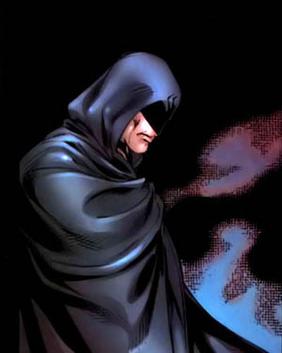Shroud (comics)
Shroud (comics) is a fictional character appearing in American comic books published by Marvel Comics. The character was created by writer Steve Englehart and artist Herb Trimpe, making his first appearance in Super-Villain Team-Up #5 in April 1976. Shroud is a superhero and a former adversary of Doctor Doom. His real name is Maximillian Coleridge, and he has no superhuman powers but relies on his Olympic-level athleticism, martial arts skills, and mastery of the darkforce dimension which allows him to manipulate darkness and shadows.
Publication History[edit | edit source]
Shroud's creation by Steve Englehart and Herb Trimpe marked the introduction of a character who was initially intended to be a villain in the Marvel Universe. However, his character development took a turn, and he became more of a vigilante and later a superhero. Over the years, Shroud has appeared in various comic book series, including his own limited series and as a member of teams such as the Night Shift and the Secret Avengers.
Fictional Character Biography[edit | edit source]
Maximillian Coleridge, born in Los Angeles, was a wealthy young man who became disillusioned with society after witnessing the murder of his parents. Seeking justice, he traveled the world to train in martial arts and the mystical arts. During a ritual in the Himalayas, he was blinded but gained the ability to tap into the darkforce dimension, which he uses to create darkness, become intangible, and see in the dark.
Upon returning to the United States, Coleridge adopted the identity of the Shroud and decided to infiltrate the criminal underworld to fight crime from within. He has been a member of various teams and has had numerous encounters with both heroes and villains in the Marvel Universe. Despite his methods sometimes being questioned by other heroes, the Shroud has always been driven by a desire to protect the innocent.
Powers and Abilities[edit | edit source]
The Shroud has no inherent superhuman powers but is a master martial artist and an Olympic-level athlete. His primary ability comes from his connection to the darkforce dimension, which allows him to manipulate darkness. He can envelop areas in absolute darkness, become intangible by merging with shadows, and see perfectly in the dark. Additionally, his training in the mystical arts has given him a resistance to certain magical attacks.
Supporting Characters[edit | edit source]
Throughout his adventures, Shroud has interacted with a wide array of characters in the Marvel Universe, including allies such as Spider-Man and Captain America, and enemies like Doctor Doom. He has also been a mentor to younger heroes and a pivotal member of teams like the Night Shift, where he often takes on a leadership role.
Reception and Legacy[edit | edit source]
Shroud remains a relatively obscure character in the Marvel Comics universe but has a dedicated fan base. His unique approach to crime-fighting and his moral complexity have been highlighted as standout features. Critics and fans alike have praised his deep backstory and the exploration of themes such as justice, vengeance, and redemption in his stories.
Appearances in Other Media[edit | edit source]
While Shroud has not been featured prominently in mainstream media adaptations such as films and television series, he has appeared in various Marvel Comics video games and merchandise, further cementing his place in the Marvel Universe.
See Also[edit | edit source]
Navigation: Wellness - Encyclopedia - Health topics - Disease Index - Drugs - World Directory - Gray's Anatomy - Keto diet - Recipes
Search WikiMD
Ad.Tired of being Overweight? Try W8MD's physician weight loss program.
Semaglutide (Ozempic / Wegovy and Tirzepatide (Mounjaro / Zepbound) available.
Advertise on WikiMD
WikiMD is not a substitute for professional medical advice. See full disclaimer.
Credits:Most images are courtesy of Wikimedia commons, and templates Wikipedia, licensed under CC BY SA or similar.Contributors: Prab R. Tumpati, MD

